(完整)新人教版七年级上册英语教案Unit4
- 格式:doc
- 大小:115.02 KB
- 文档页数:6
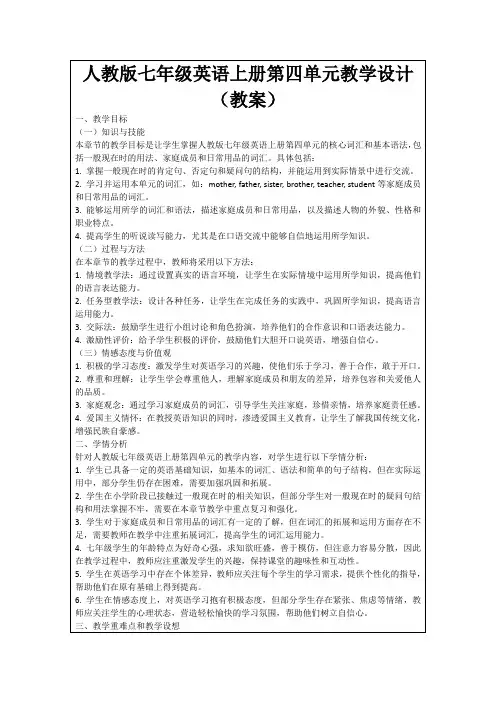

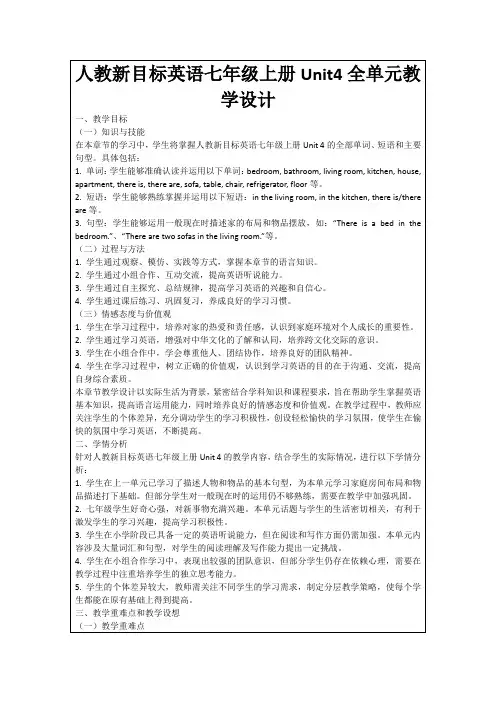
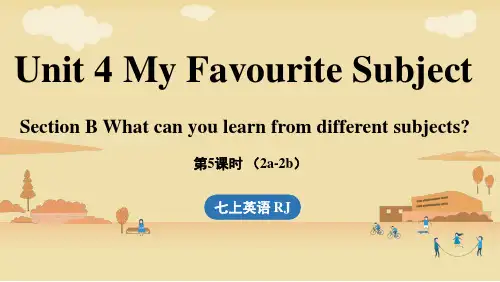
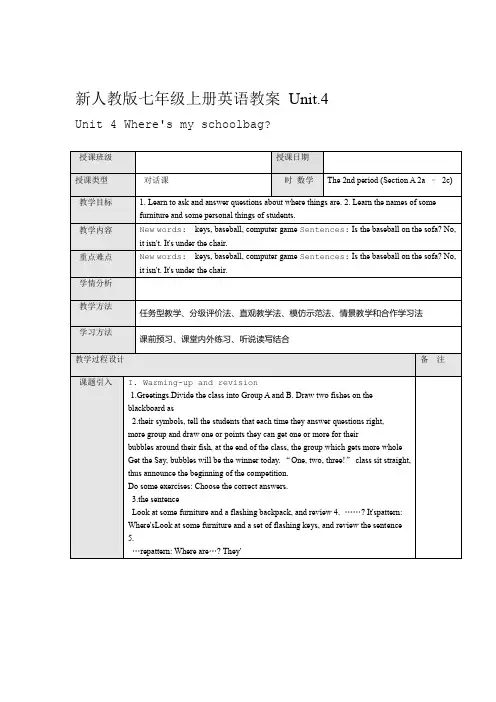
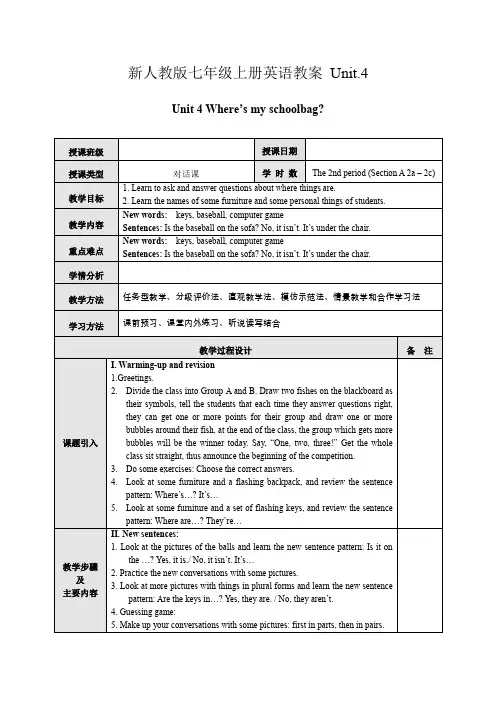
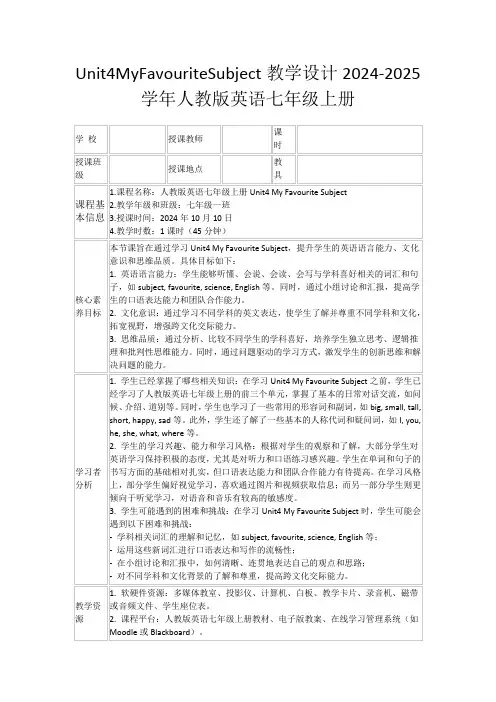
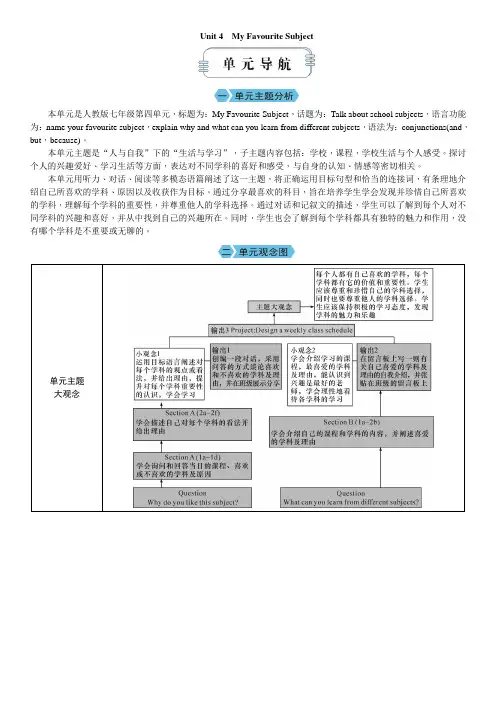
Unit 4 My Favourite Subject本单元是人教版七年级第四单元,标题为:My Favourite Subject,话题为:Talk about school subjects,语言功能为:name your favourite subject,explain why and what can you learn from different subjects,语法为:conjunctions(and,but,because)。
本单元主题是“人与自我”下的“生活与学习”,子主题内容包括:学校,课程,学校生活与个人感受。
探讨个人的兴趣爱好、学习生活等方面,表达对不同学科的喜好和感受,与自身的认知、情感等密切相关。
本单元用听力、对话、阅读等多模态语篇阐述了这一主题,将正确运用目标句型和恰当的连接词,有条理地介绍自己所喜欢的学科、原因以及收获作为目标。
通过分享最喜欢的科目,旨在培养学生学会发现并珍惜自己所喜欢的学科,理解每个学科的重要性,并尊重他人的学科选择。
通过对话和记叙文的描述,学生可以了解到每个人对不同学科的兴趣和喜好,并从中找到自己的兴趣所在。
同时,学生也会了解到每个学科都具有独特的魅力和作用,没有哪个学科是不重要或无聊的。
单元主题大观念单元语言大观念语言能力及技能语言能力:1.掌握与学科相关的词汇和常用表达,如:magic,useful,fun,important,subjects,difficult,easy,Chinese,history,maths,English,music,PE,geography,biology,IT,art,learn about the past,help me with my maths,work out maths problemsKey sentences:①—What's your favourite subject?—My favourite subject is…②—Why do you like…?—Because it's…③I'm good with numbers.④I'm not good at science.2.掌握双元音/e/,/a/,//,/əu/,/au/,/ə/,/eə/,/uə/的字母组合发音和单词连读。
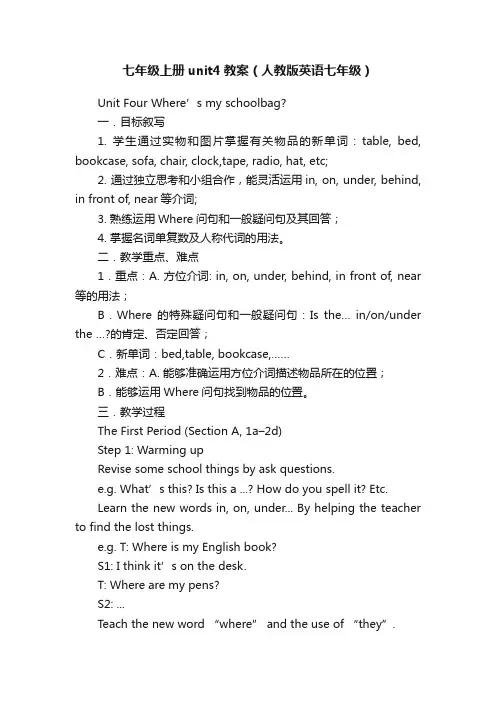
七年级上册unit4教案(人教版英语七年级)Unit Four Where’s my schoolbag?一.目标叙写1. 学生通过实物和图片掌握有关物品的新单词:table, bed, bookcase, sofa, chair, clock,tape, radio, hat, etc;2. 通过独立思考和小组合作,能灵活运用in, on, under, behind, in front of, near等介词;3. 熟练运用Where问句和一般疑问句及其回答;4. 掌握名词单复数及人称代词的用法。
二.教学重点、难点1.重点:A. 方位介词: in, on, under, behind, in front of, near 等的用法;B.Where 的特殊疑问句和一般疑问句:Is the… in/on/under the …?的肯定、否定回答;C.新单词:bed,table, bookcase,……2.难点:A. 能够准确运用方位介词描述物品所在的位置;B.能够运用Where问句找到物品的位置。
三.教学过程The First Period (Section A, 1a–2d)Step 1: Warming upRevise some school things by ask questions.e.g. What’s this? Is this a ...? How do you spell it? Etc.Learn the new words in, on, under... By helping the teacher to find the lost things.e.g. T: Where is my English book?S1: I think it’s on the desk.T: Where are my pens?S2: ...Teach the new word “where” and the use of “they”.Consolidate the prepositions by looking at the scree and answer the questions:Where’s...? Where’re...?Step2: PresentationLook and findT: Please look at the picture in activity 1a. There are some things in it. Do you know what they are?Match and discussa. T: Would you please match the words with the things in the picture?b. T: How many words do you know? Can you share the words you know with your partners?c. T: Please discuss with your partners and check whether your answers are the same.3.Check the answers4.ReadT: Please read the words after me. Table ...Step 3: Listen and numberT: Listen to the recording of 1b for the first time.T: Number the things in the picture when you listen to it for the second time.Read the sentencesa. T: I would like you to read the tape script together.b. T: Would you please read it by yourselves three times?Translate and explaina. T: Let’s translate the conversation into Chinese.b. T: Who can tell us what it means?c. T: Yes. When we ask the positions of things, we use the word “where”. And from the picture, we know that the word “on” means “在上面” “in” means “在里面” “under”means “在下面”. They are called prepositions “介词”。
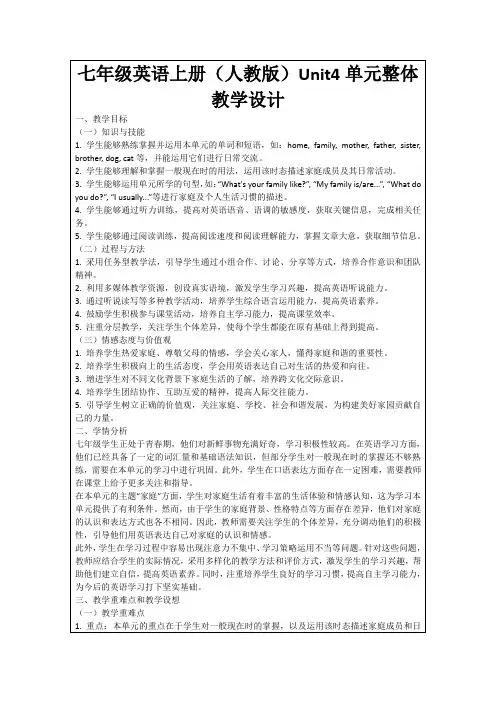
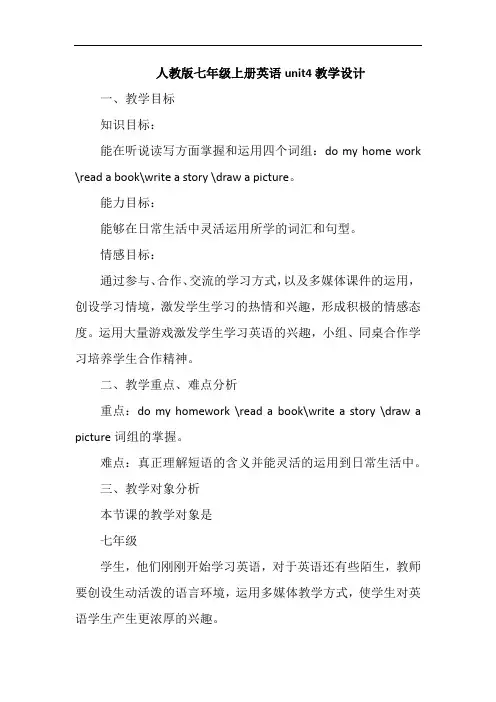
人教版七年级上册英语unit4教学设计一、教学目标知识目标:能在听说读写方面掌握和运用四个词组:do my home work \read a book\write a story \draw a picture。
能力目标:能够在日常生活中灵活运用所学的词汇和句型。
情感目标:通过参与、合作、交流的学习方式,以及多媒体课件的运用,创设学习情境,激发学生学习的热情和兴趣,形成积极的情感态度。
运用大量游戏激发学生学习英语的兴趣,小组、同桌合作学习培养学生合作精神。
二、教学重点、难点分析重点:do my homework \read a book\write a story \draw a picture词组的掌握。
难点:真正理解短语的含义并能灵活的运用到日常生活中。
三、教学对象分析本节课的教学对象是七年级学生,他们刚刚开始学习英语,对于英语还有些陌生,教师要创设生动活泼的语言环境,运用多媒体教学方式,使学生对英语学生产生更浓厚的兴趣。
四、课前准备1.单词卡片及录音带。
2.自制课件。
五、教学设计思想本课教学以学生为主体,以训练为主线,以能力的培养为宗旨。
综合运用讲授式,启发式,创设情景和自主学习等策略进行教学,将集体学习与小组学习相结合,注重师生互动与生生互动,通过表演、游戏、和充分利用多媒体课件等教学途径,提高学生综合运用英语的能力;英语与信息技术的整合,使教学更加明了、快捷、方便,从而让学生掌握更加正确规范的英语。
同时实现教学内容的呈现方式、学生学习方式、教师的教学方式以及师生互动方式的变革,充分发挥信息技术的优势,为学生的学习和进一步发展提供丰富多彩的教育环境和有力的学习工具,拓宽学生的视野。
六、媒体设计思路在英语课堂教学中,适时、合理地运用多媒体辅助教学,可以优化教学过程。
多媒体课件中设置了较多的与课堂教学内容关系密切的图片,给学生以乐趣,更给学生以启迪,为学生创设了自主学习的情境,有利于激发学生的学习兴趣与热情,培养合作意识,提高教学效率。
人教版七年级英语上册第4单元Unit4教案Unit 4 Lesson Plan for Grade 7 English (Textbook: People’s Education Press) Lesson Overview- Unit: 4- Textbook: Grade: 7- Subject: English- Duration: 1 week- Lesson Title: Unit 4Lesson Objectives- Develop the students' listening, speaking, reading, and writing skills in English- Enhance the students' understanding of basic grammar rules and vocabularyLesson ContentThis lesson will cover the following topics and activities:1. Vocabulary- Introduce and practice vocabulary related to daily routines, such as wake up, get dressed, eat breakfast, go to school, etc.2. Listening- Listen to audio recordings of different daily routines and identify the corresponding activities3. Speaking- Practice speaking about personal daily routines and ask and answer questions about others' routines4. Reading5. Writing- Write a short paragraph describing a personal daily routine using the vocabulary and grammar learned in class6. Grammar- Review and practice the use of present simple tense in sentences related to daily routines- Engage in pair or group discussions about daily routines and exchange information8. Evaluation- Assess the students' understanding through quizzes, oral presentations, and written assignmentsLesson PlanDay 1: Vocabulary and Listening- Introduce the new vocabulary related to daily routines- Play audio recordings of different daily routines- Have students match the activities with the corresponding recordings- Discuss the correct answers as a classDay 2: Speaking and Reading- Practice speaking about personal daily routines in pairs or small groups- Introduce the reading passage about a teenager's typical day- Discuss the answers as a classDay 3: Writing and Grammar- Review the present simple tense and its usage in sentences related to daily routines- Provide a writing prompt asking students to describe their own daily routines- Have students write a short paragraph using the vocabulary and grammar learned- Divide the class into pairs or small groups- Assign each group a set of questions related to daily routines- Have the groups discuss the questions and exchange information - Assess the students' understanding through oral presentations and participationResources- Textbook: People's Education Press Grade 7 English- Audio recordings of daily routines- Reading passage about a teenager's daily routine- Writing prompts for students to describe their daily routinesAssessment- Quizzes to test vocabulary knowledge- Evaluation of written paragraphs describing daily routines- Oral presentations and participation in group discussionsConclusion。
Unit 4 Where’s my schoolbag?一、教学目标1.学习一些有关家具物品和学习用品的单词2.运用方位借此表述物体位置3.掌握where问句的回答、一般疑问句提问并用方位介词回答4.学习名词单复数及人称代词they的用法二、能力目标1.学会正确描述物品作在的位置;2.学会询问自己或他人物品的具体位置;3.能够合理地描述和设计房间。
三、情感目标培养学生整齐地摆放自己物品的生活习惯。
四、语言目标1.词汇: Rooms of the house, furniture, table, bed, sofa, chair, desk, radio, clock, tape, tape player, model plane, on, under, where, their, Come on2.句型:Where is his pencil?It is in his schoolbag.Where’s your ruler?It’s under the chair.Where are my books?They’re on the sofa.五、教学重点:1.方位借此in, on, under, behind, in front of, near等的用法2.where的特殊疑问句和一般疑问句Is the…in/on/under…?的肯定、否定回答。
3.新单词: bed, dresser, table, bookcase, backpack…六、教学难点:1.能够准确运用方位借此描述物品所在的位置2.能够运用where问句找到物品的位置。
七、课时安排The 1st period (第一课时): Section A (1a –2d)The 2nd period (第二课时): Section A (Grammar focus – 3c)The 3rd period (第三课时): Section B (1a- 1e)The 4th period (第四课时): Section B (2a- 2c )The 5th period (第五课时): Section B (3a- Self Check )The 1st period (第一课时): Section A (1a –2d)Teaching aims(教学目标)1. 掌握有关物品的名称table, bed, dresser, bookcase, sofa, chair, drawer, plant, bag, alarm clock, CD, video, video cassette, hat, etc;2. 学会谈论物品的位置。